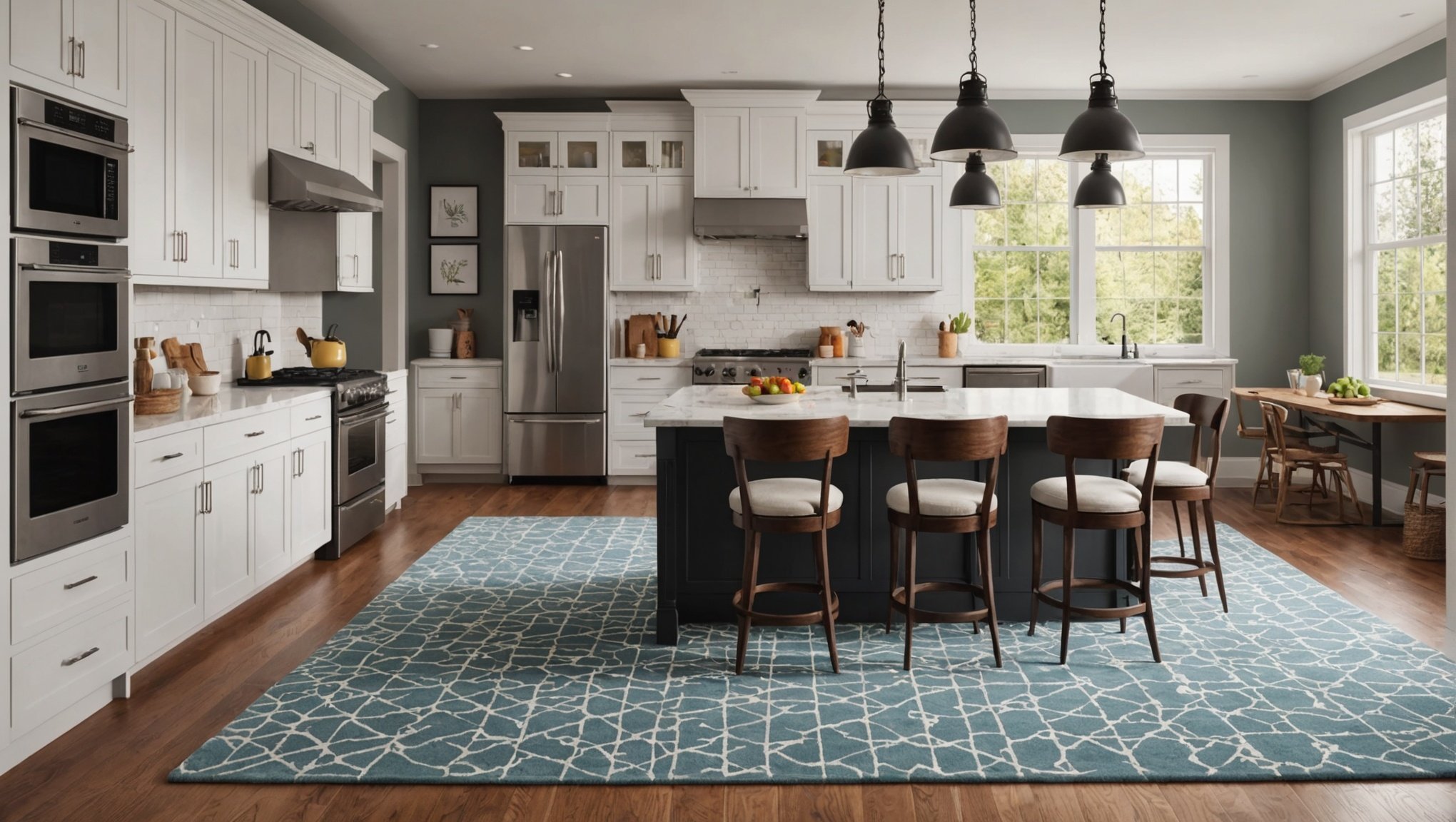Selecting a kitchen rug involves more than just choosing a pretty design. A well-chosen rug enhances comfort underfoot, adds warmth to the space, and complements your kitchen’s overall aesthetic. With countless options available, balancing functionality and style can seem daunting. This guide demystifies the process, highlighting key considerations and practical tips. Whether you’re aiming for a chic, modern look or a cozy, rustic feel, you’re sure to find a perfect fit that meets both your practical needs and aesthetic preferences.
Understanding Kitchen Rug Functionality
Kitchen rugs serve a crucial role in both practicality and aesthetics within the home. Selecting the right material is essential to ensure that your rug meets the demands of your culinary space. Materials like cotton, wool, or synthetic fibres can offer varying levels of durability and comfort underfoot.
Also read : Selecting the Perfect Extractor Fan: Achieve Optimal Power with Whisper-Quiet Performance!
When considering a kitchen rug, it’s vital to focus on key functional features. Stain resistance is a top priority, given the likelihood of spills and splashes. Rugs with easy-to-clean surfaces can significantly reduce maintenance efforts. Additionally, a non-slip backing is crucial for enhancing safety, preventing accidents in a bustling kitchen environment.
Beyond these practical advantages, kitchen rugs also protect flooring from wear and tear. They act as a barrier against scratches and dents, especially in high-traffic areas. This protection is particularly beneficial for preserving the integrity of hardwood or tile floors, which can be costly to repair.
Topic to read : Selecting the Perfect Extractor Fan: Achieve Optimal Power with Whisper-Quiet Performance!
In summary, understanding the purpose and functionality of kitchen rugs can help you make an informed choice. By prioritising materials and features that align with your needs, you can enhance both the safety and longevity of your kitchen space.
Choosing the Right Size and Shape
Selecting the appropriate kitchen rug dimensions is essential for achieving a harmonious look and feel in your culinary space. When planning your kitchen layout, consider both the size and shape of the rug to ensure it complements the room’s design.
Guidelines for Measuring Your Kitchen Space
Start by measuring the area where you intend to place the rug. This ensures the rug fits well without overwhelming the space. For example, if you’re placing a rug near the sink or stove, ensure there is enough room to move comfortably. Space planning is crucial to avoid clutter and maintain functionality.
Popular Rug Shapes and Their Suitable Placements
Different rug shapes can serve various purposes in the kitchen. Runners are ideal for narrow spaces, such as between countertops, while area rugs can define larger spaces, like dining areas. Consider the flow of movement in your kitchen to determine the best placement for each shape.
Tips for Creating a Balanced Layout
To achieve a balanced layout, ensure the rug does not obstruct any kitchen elements, such as cabinet doors or appliances. A well-placed rug can enhance the room’s aesthetics while maintaining practicality. By carefully considering your kitchen’s dimensions and layout, you can select a rug that adds both functionality and style.
Selecting Colors and Patterns
Choosing the right kitchen rug colors can significantly enhance the aesthetic appeal of your culinary space. When selecting colors, consider your kitchen’s overall decor. Neutral tones like beige or grey can seamlessly blend with various styles, while bold hues like red or blue can add a vibrant touch. It’s crucial to strike a balance between the rug and existing elements to prevent clashing.
Trends in Patterns and Prints
Current design trends in kitchen rugs include geometric patterns, floral prints, and abstract designs. Geometric patterns offer a modern look, often featuring clean lines and shapes that can complement contemporary kitchens. Floral prints can introduce a touch of nature and warmth, perfect for traditional or rustic settings. Abstract designs, with their unique and artistic flair, can become a focal point in minimalist spaces.
Tips for Achieving Visual Harmony
To ensure visual harmony, match the rug’s color palette with key kitchen elements like cabinetry or countertops. Consider the kitchen’s lighting as well; a well-lit space can accommodate darker rugs without feeling cramped. Additionally, if your kitchen features intricate decor, opt for simpler rug patterns to maintain balance. By thoughtfully selecting kitchen rug colors and patterns, you can create a cohesive and inviting kitchen environment.
Maintenance and Care for Kitchen Rugs
Proper rug care is essential to maintain both the appearance and longevity of your kitchen rug. Understanding the cleaning methods suitable for different materials can make all the difference. For cotton rugs, regular machine washing is advisable, whereas wool rugs benefit from gentle vacuuming and spot cleaning. Synthetic fibres often require a simple wipe-down with a damp cloth, making them a convenient option for busy households.
The frequency of cleaning tasks should be tailored to your kitchen’s activity level. High-traffic areas might necessitate weekly vacuuming to prevent dirt accumulation. For spills, immediate attention is crucial to avoid permanent stains. Spot cleaning with a mild detergent can effectively address most kitchen mishaps.
To prolong the life of your kitchen rug, consider these practical tips:
- Rotate the rug periodically to ensure even wear.
- Use a rug pad to reduce friction and enhance comfort.
- Avoid direct sunlight to prevent fading.
By adhering to these rug care tips, you can significantly extend your rug’s lifespan and maintain its aesthetic appeal. Consistent maintenance not only preserves the rug’s functionality but also contributes to a cleaner, more inviting kitchen environment.
Visual Inspiration and Style Ideas
Exploring various kitchen rug styles can transform your culinary space into a cohesive and stylish environment. Whether you lean towards a modern, farmhouse, or traditional aesthetic, there’s a rug to suit every taste.
Examples of Kitchen Rug Styles
- Modern Rugs: These often feature sleek designs with geometric patterns or abstract art, perfect for contemporary kitchens.
- Farmhouse Rugs: Known for their rustic charm, these rugs typically showcase earthy tones and natural fibres, complementing wooden cabinetry.
- Traditional Rugs: With intricate patterns and rich colours, traditional rugs add a touch of elegance and warmth to any kitchen.
Integrating Rugs into Kitchen Design
Integrating a rug into your kitchen decor requires careful consideration of existing elements. Align the rug’s colour scheme with your kitchen’s palette to ensure harmony. For instance, pair a bold-patterned rug with neutral cabinetry to create a balanced look.
Checklist for Selecting and Styling
- Match the Style: Choose a rug that aligns with your kitchen’s theme.
- Consider Size and Shape: Ensure the rug fits well in the intended space without obstructing movement.
- Evaluate Material: Select materials that offer durability and ease of maintenance.
- Focus on Functionality: Opt for rugs with non-slip backings for safety.
By following these guidelines, you can seamlessly integrate a stylish rug into your kitchen, enhancing both its functionality and aesthetic appeal.






